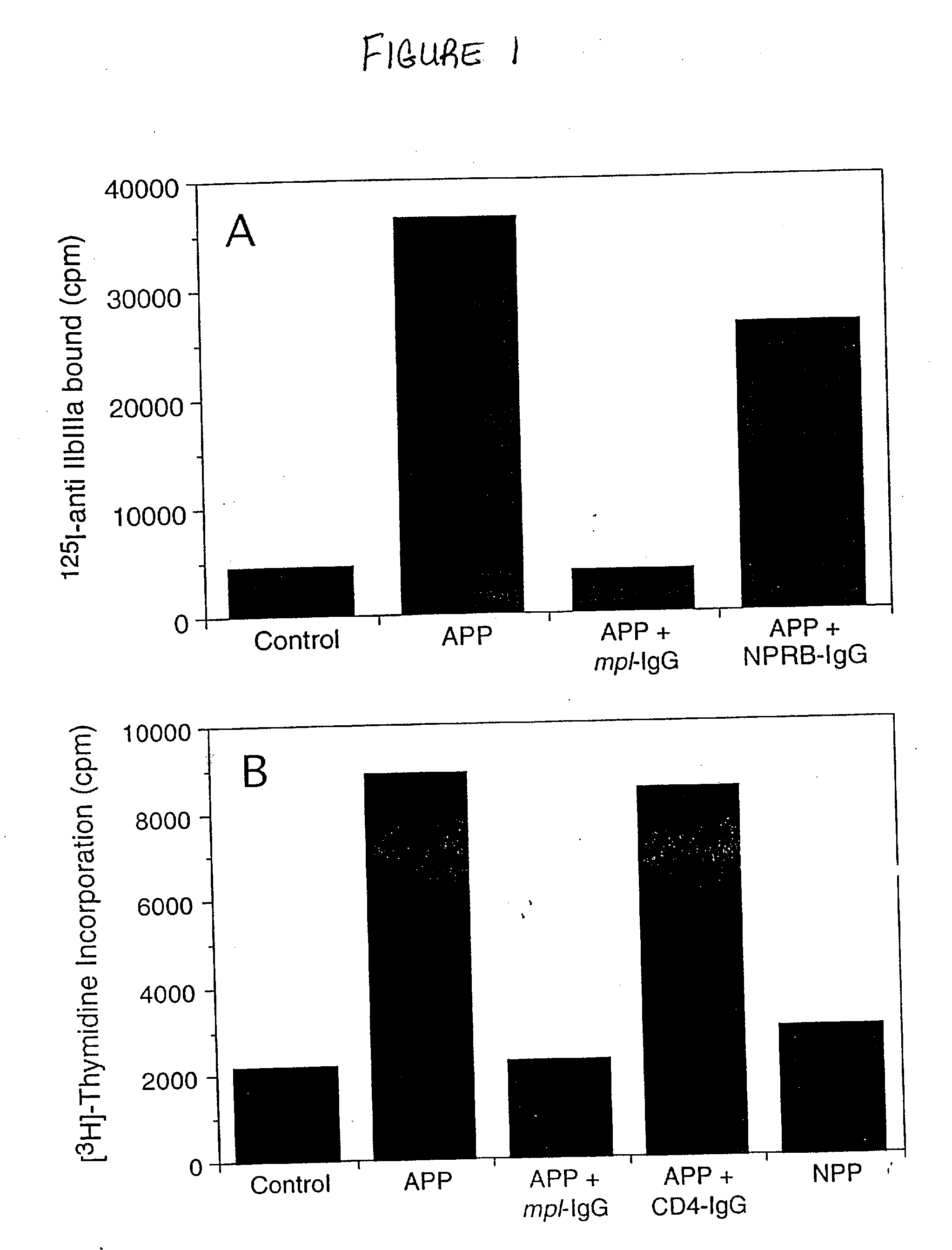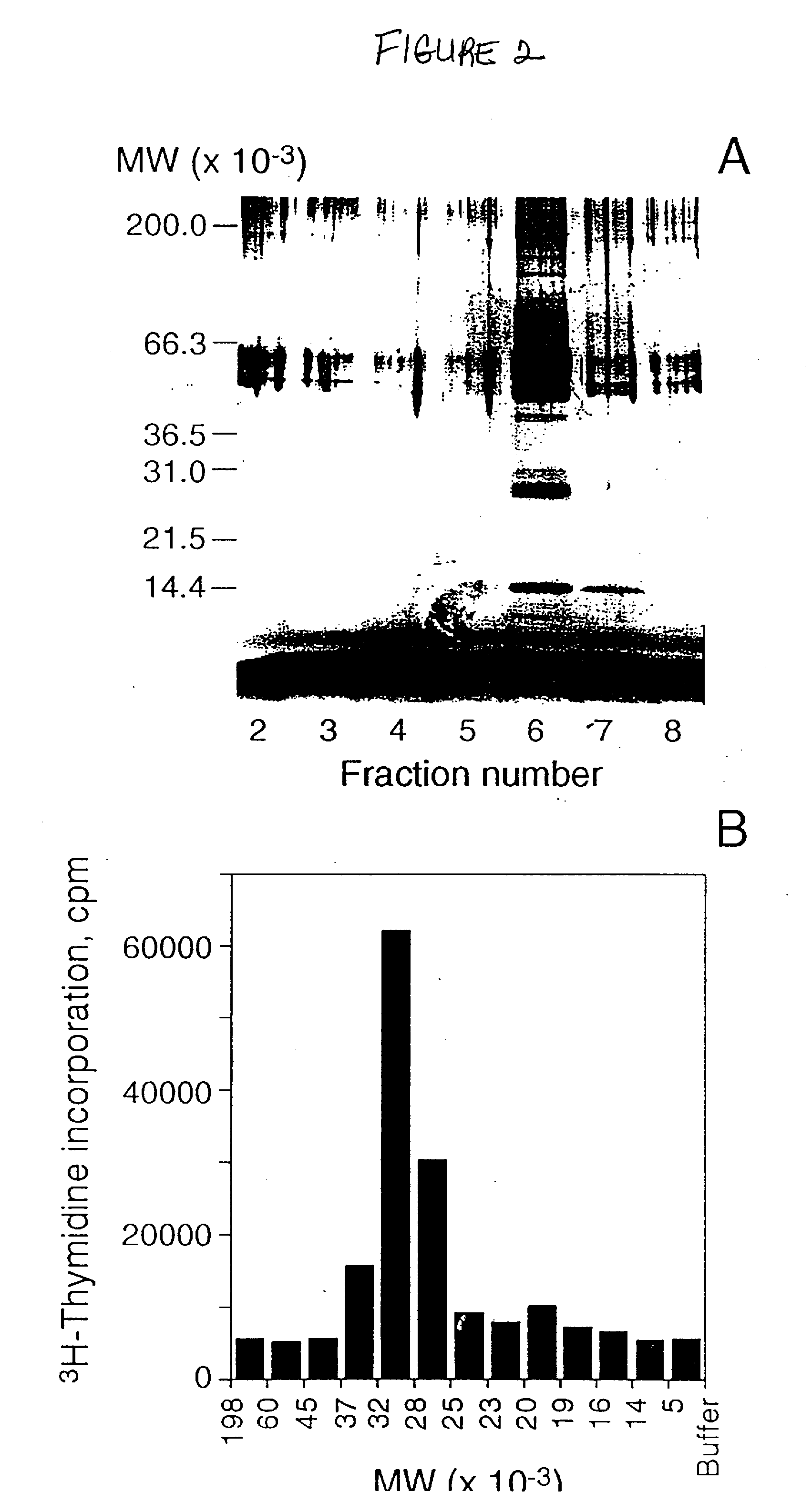c-Mpl LIGAND POLYPEPTIDE
a ligand polypeptide and ligand technology, applied in the field of ligand polypeptides, can solve the problems of unsuccessful purification efforts, and achieve the effect of stimulating mammalian megakaryocytopoiesis and increasing platelet levels
- Summary
- Abstract
- Description
- Claims
- Application Information
AI Technical Summary
Benefits of technology
Problems solved by technology
Method used
Image
Examples
example i
Stimulation by APP, and Inhibition by Mpl Receptor-IgG, of Human in vitro Megakaryocytopoiesis Using the Liquid Suspension Megakaryocytopoiesis Assay
[0025]APP obtained from irradiated pigs was found to stimulate human megakaryocytopoiesis in vitro (FIG. 1(a)). To determine whether this stimulation was dependent on the presence of ML, a human Mpl receptor-IgG fusion protein containing the extracellular domain of Mpl receptor (Example II) was used in an attempt to neutralize this activity.
[0026]Platelet-poor plasma was collected from normal or aplastic anaemic pigs. Pigs were rendered aplastic by irradiation with 900 cGy of total body irradiation using a 4 meV linear accelerator. The irradiated pigs were supported for 6-8 days with intramuscular injections of cefazolin. Subsequently, their total blood volume was removed under general anaesthesia, heparinized, and centrifuged at 1,800×g for 30 min to make platelet-poor plasma. The megakaryocyte-stimulating activity was found to peak 6 ...
example ii
Production of Mpl Receptor-IgG Fusion Protein
[0029]A cDNA fragment encoding amino acids 1-491 of human Mpl receptor (which region contains the extracellular domain of human Mpl receptor) was obtained by PCR from a human megakaryocytic CMK cell cDNA library and fused in-frame to a cDNA encoding the Fc region of human IgGl, as described in B. D. Bennett et al., J. Biol. Chem., 266, 23060-23067 (1991), incorporated herein by reference. The Mpl receptor-IgG construct was subcloned into pRK5-tkneo and transfected into 293 human embryonic kidney cells by the calcium phosphate method (C. Gorman in DNA Cloning: A New Approach, 2, 143-190, (IRL, Washington, 1985)). The cells were selected in 0.4 mg ml−1 G418 and individual clones were isolated. Mpl receptor-IgG expression from isolated clones was determined using a human Fc-specific ELISA. The recombinant Mpl receptor-IgG was purified on a protein A-Sepharose column (Pharmacia).
example iii
Development of the Ba / F3-mpl Cell Proliferation Assay
[0030]To facilitate purification of ML, an Mpl-receptor-dependent cell proliferation assay was developed. It was known that the stable expression of several different growth factor receptors in factor-dependent cell lines confers responsiveness to the respective growth factor (R. Palacios et al., Cell, 41, 727-734 (1985); A. D. D'Anrea et al., Mol. Cell. Biol., 11, 1980-1987 (1991); T. Kitamura et al., Proc. Natl. Acad. Sci. USA, 88, 5082-5086 (1991)). It was also known that the cytoplasmic domain of c-Mpl receptor can transduce a proliferation signal (R. C. Skoda et al., EMBO J., 12, 2645-2653 (1993); I. Vigon et al., Oncogene, 8, 2607-2615 (1993)) and that the extracellular domain of c-Mpl receptor appeared to bind ML (Example I, FIG. 1(a)). Speculating that the c-Mpl receptor might be therefore a single-chain receptor, the c-mpl gene was accordingly expressed in the murine interleukin-3-dependent cell line, Ba / F3 (R. Palacios e...
PUM
| Property | Measurement | Unit |
|---|---|---|
| liquid suspension megakaryocytopoiesis assay | aaaaa | aaaaa |
| volume | aaaaa | aaaaa |
| hydrophobic interaction chromatography | aaaaa | aaaaa |
Abstract
Description
Claims
Application Information
 Login to View More
Login to View More - R&D
- Intellectual Property
- Life Sciences
- Materials
- Tech Scout
- Unparalleled Data Quality
- Higher Quality Content
- 60% Fewer Hallucinations
Browse by: Latest US Patents, China's latest patents, Technical Efficacy Thesaurus, Application Domain, Technology Topic, Popular Technical Reports.
© 2025 PatSnap. All rights reserved.Legal|Privacy policy|Modern Slavery Act Transparency Statement|Sitemap|About US| Contact US: help@patsnap.com



